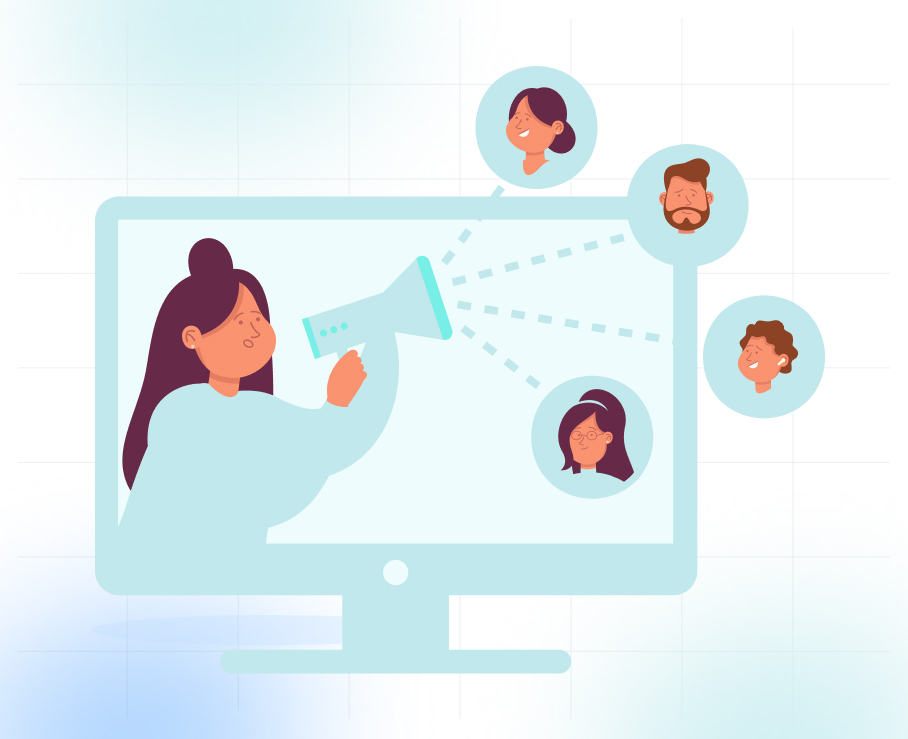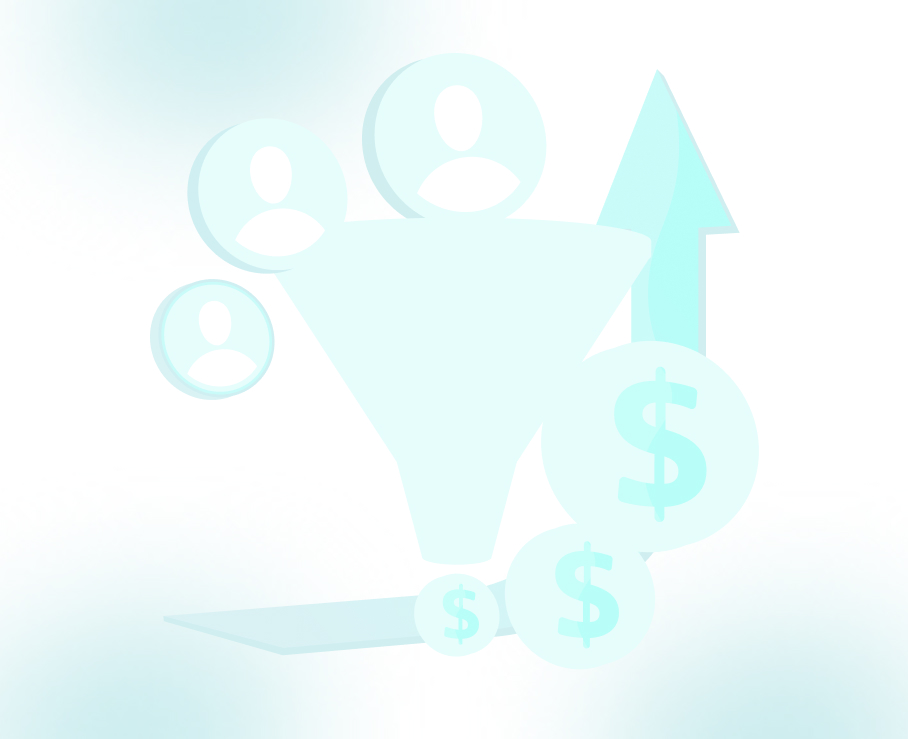
Effective Data-Driven Strategies for B2B Demand Generation

Your sales team can’t afford to waste time chasing leads that won’t convert. As a Sales Manager or Business Development head, you’re expected to bring in high-intent opportunities, fast. But with inboxes full of noise, shifting buyer behaviors, and rising competition, that’s easier said than done. Add to that the pressure of proving ROI and filling your pipeline with real decision-makers, and the stakes only grow.
By 2025, 80% of B2B sales Your sales team can’t afford to waste time chasing leads that won’t convert. As a Sales Manager or Business Development head, you’re expected to bring in high-intent opportunities, fast. But with inboxes full of noise, shifting buyer behaviors, and rising competition, that’s easier said than done. Add to that the pressure of proving ROI and filling your pipeline with real decision-makers, and the stakes only grow.
By 2025, 80% of B2B sales interactions between buyers and suppliers will happen in digital channels. Your prospects are already moving faster, researching smarter, and expecting more personalized outreach. Video use in B2B has jumped by 41%, and chat-based interactions have grown by 23%. What does that tell you? Static, guess-based strategies no longer suffice.
You need a data-driven demand generation strategy, one that sharpens your targeting, warms up your outreach, and delivers leads who are ready to talk.
Let’s break down what B2B demand generation means and how you can use data to power it.
TL;DR
- Data-driven demand generation helps you reach qualified buyers and cut wasted outreach.
- Combining verified data, tailored messaging, and intent signals drives better MRR outcomes.
- Email, gated assets, and syndication work best when campaigns align with buyer stages.
- Avoid generic tactics, track SQLs, refine audiences, and focus on scalable growth.
What is B2B Demand Generation?
B2B demand generation is a structured way to build interest and attract the right buyers to your business. It focuses on quality over quantity, helping you connect with decision-makers who are more likely to convert and contribute to long-term revenue. Here's what shapes a strong demand generation strategy:
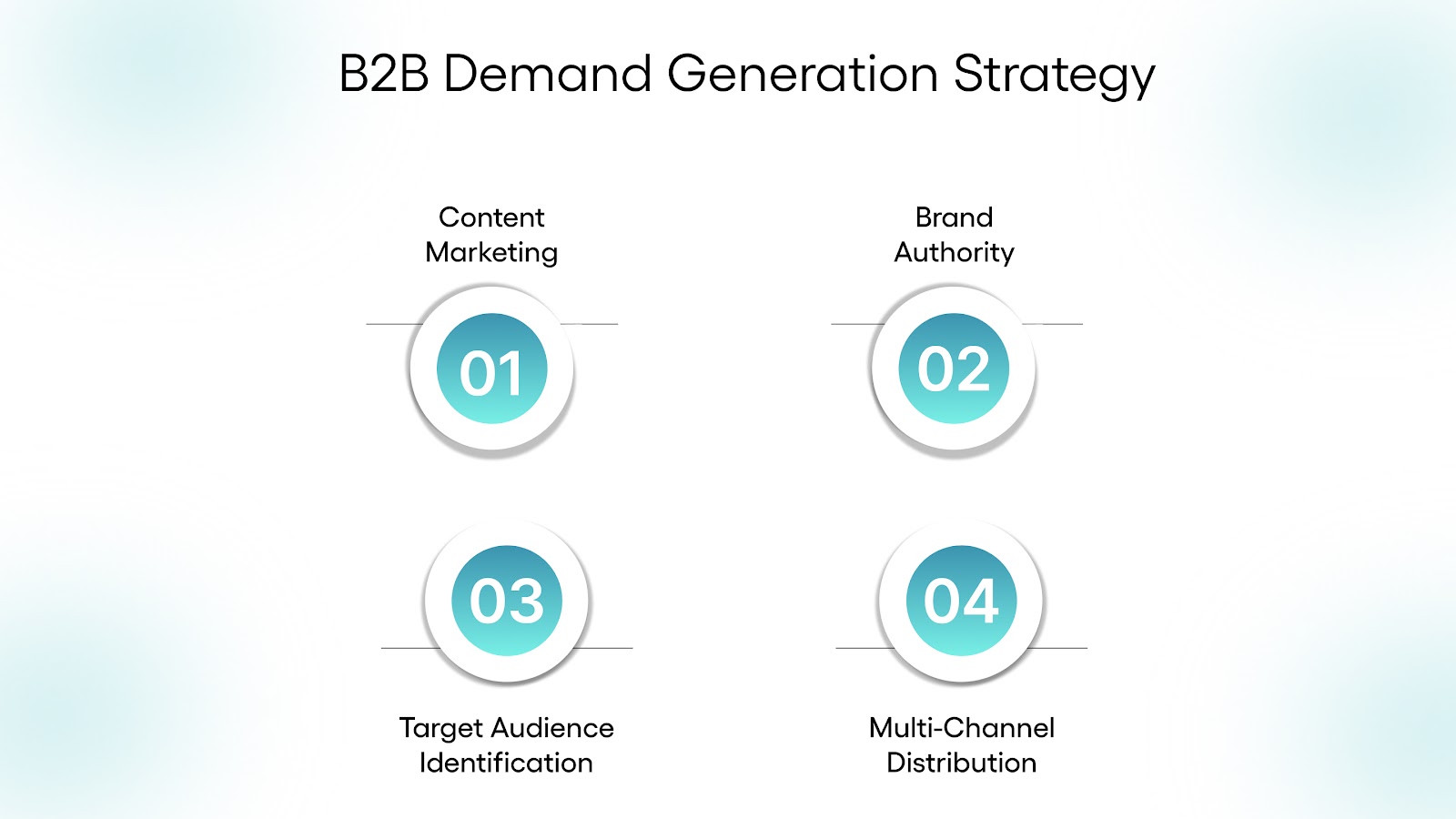
Content Marketing: Publish content that directly answers real buyer questions at the right stage of their journey.
Brand Authority: Build trust by showing up with timely, helpful messaging backed by real industry insights.
Target Audience Identification: Define and refine your ideal customer profile using role, industry, and intent, not assumptions.
Multi-Channel Distribution: Use high-impact channels like compliant email to reach buyers where they already pay attention.
Looking to attract more qualified leads and build a pipeline that converts? Explore TLM’s Demand Generation Services to see how better targeting leads to stronger MRR.
Demand Generation vs Lead Generation
If your team’s under pressure to bring in better leads, cut down wasted outreach, and grow MRR without cold calling, knowing the difference between demand generation and lead generation becomes essential.
Both work toward building your pipeline, but they do it in very different ways. Demand generation focuses on helping potential buyers get to know your brand early. It’s about sparking interest before they’re even thinking about buying. Lead generation comes in when that interest is strong enough, you collect contact details, and move those prospects toward a conversation. One builds awareness. The other moves are toward awareness and action.
Here’s how they differ:
TLM (The Lead Market) supports both strategies with CAN-SPAM-compliant outreach and targeted campaigns. Demand generation efforts help position your brand in front of the right audience early, while lead generation services, like SQL delivery and B2B appointment scheduling, convert that attention into real meetings and higher MRR.
Next, let’s explore the actual benefits of a data-driven demand generation strategy.
Also Read: Top 8 Outbound Lead Generation Strategies for 2025
Key Benefits of a Data-Driven Demand Generation Strategy
If your team’s efforts aren’t moving the MRR needle, it’s often a sign that the strategy lacks direction. A data-driven demand generation approach helps you identify tactics that focus on what works and keep every campaign grounded in real signals, not assumptions.
Here’s what that shift delivers:
- Campaigns feel more relevant because they’re shaped by actual buyer behavior, not guesswork.
- Outreach becomes sharper with messaging tailored to what matters most to each decision-maker.
- Sales teams stop wasting time on low-intent leads and start having conversations that lead somewhere.
- Performance doesn’t stall; you’re constantly improving based on what your numbers show, not gut feel.
- Retention improves too, with better post-sale touchpoints that help grow accounts, not just win them.
This is exactly why firms using services like TLM’s demand generation see stronger consistency, because targeting, timing, and messaging are aligned from day one, not left to trial and error.
A Pennsylvania-based MSP experienced this first-hand, by running a focused demand generation campaign targeting the life sciences sector, they closed a $20,000 MRR deal within 60 days. With personalized outreach and early technical involvement, they secured a 3-year contract worth $720,000 while shortening their sales cycle by 40%.
Now, let’s break down how a strong B2B demand generation system works in action.
How Does B2B Demand Generation Work?
When you’re expected to show pipeline progress, waiting on inbound interest isn’t an option. Demand generation steps in to build early intent, qualify the right accounts, and maintain engagement through every stage.
Here’s how the process typically works:
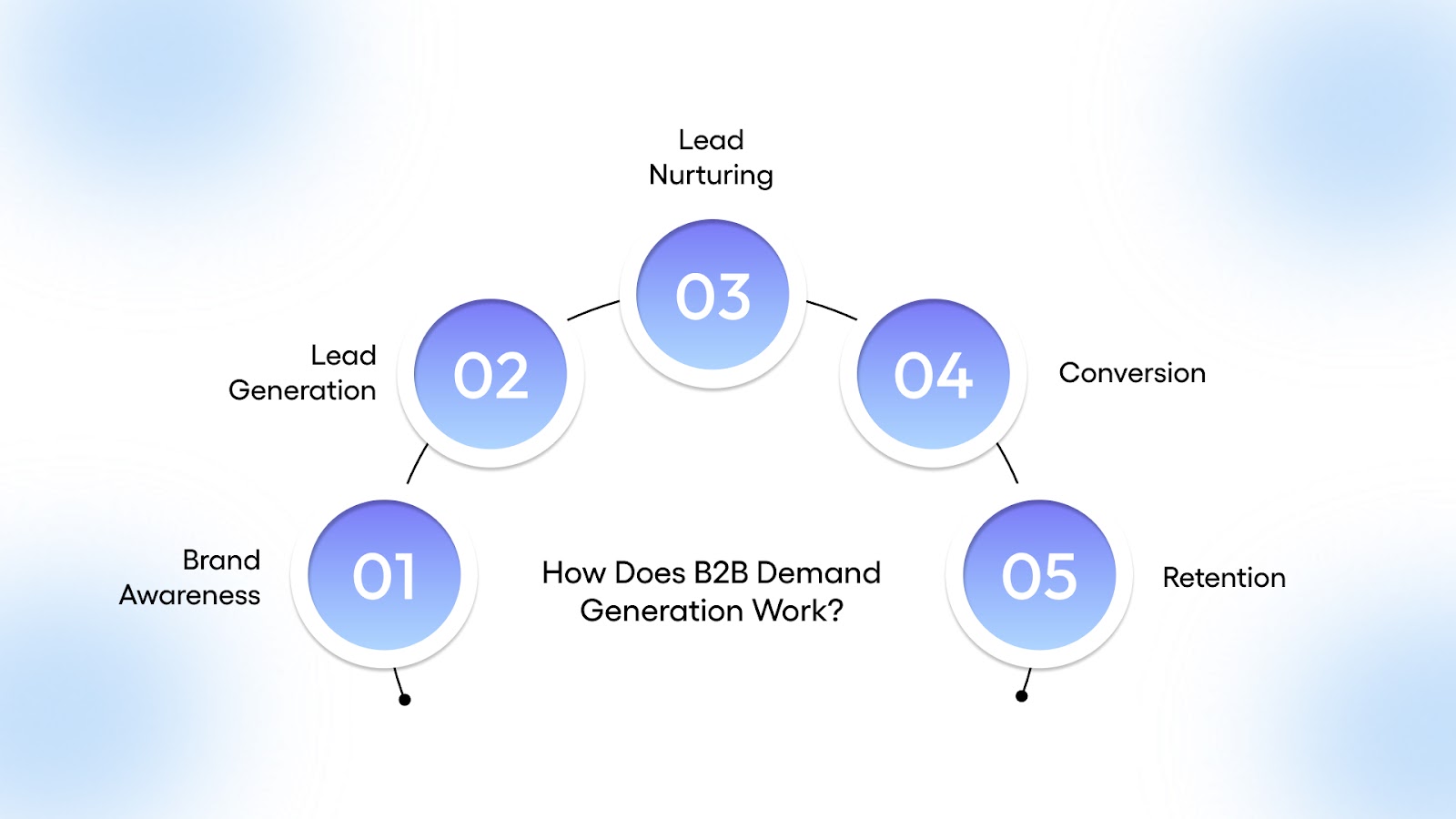
- Brand Awareness: You begin by creating visibility. Educational, insight-driven content helps the right prospects find you and understand your relevance early.
- Lead Generation: Once attention is earned, the goal is to collect verified contact information. This happens through targeted email campaigns and gated content, not through cold calls.
- Lead Nurturing: Most leads won’t convert immediately. Timely follow-ups, custom content, and ongoing communication keep interest alive and move leads toward readiness.
- Conversion: At this stage, intent is clear. Prospects are sales-ready and passed forward only once qualified, reducing time wasted on poor-fit leads.
- Retention: Even after a sale, demand generation keeps working. Consistent post-purchase value builds loyalty and strengthens future MRR.
This is how you build a steady, repeatable system, where demand isn’t just captured, it’s created and sustained. Every stage in this system can be optimized using the right strategy, and that’s what we’ll explore next.
Also Read: Effective Lead Generation Strategies for B2B SaaS Startups to drive growth
Data-Driven B2B Demand Generation Strategies to Implement
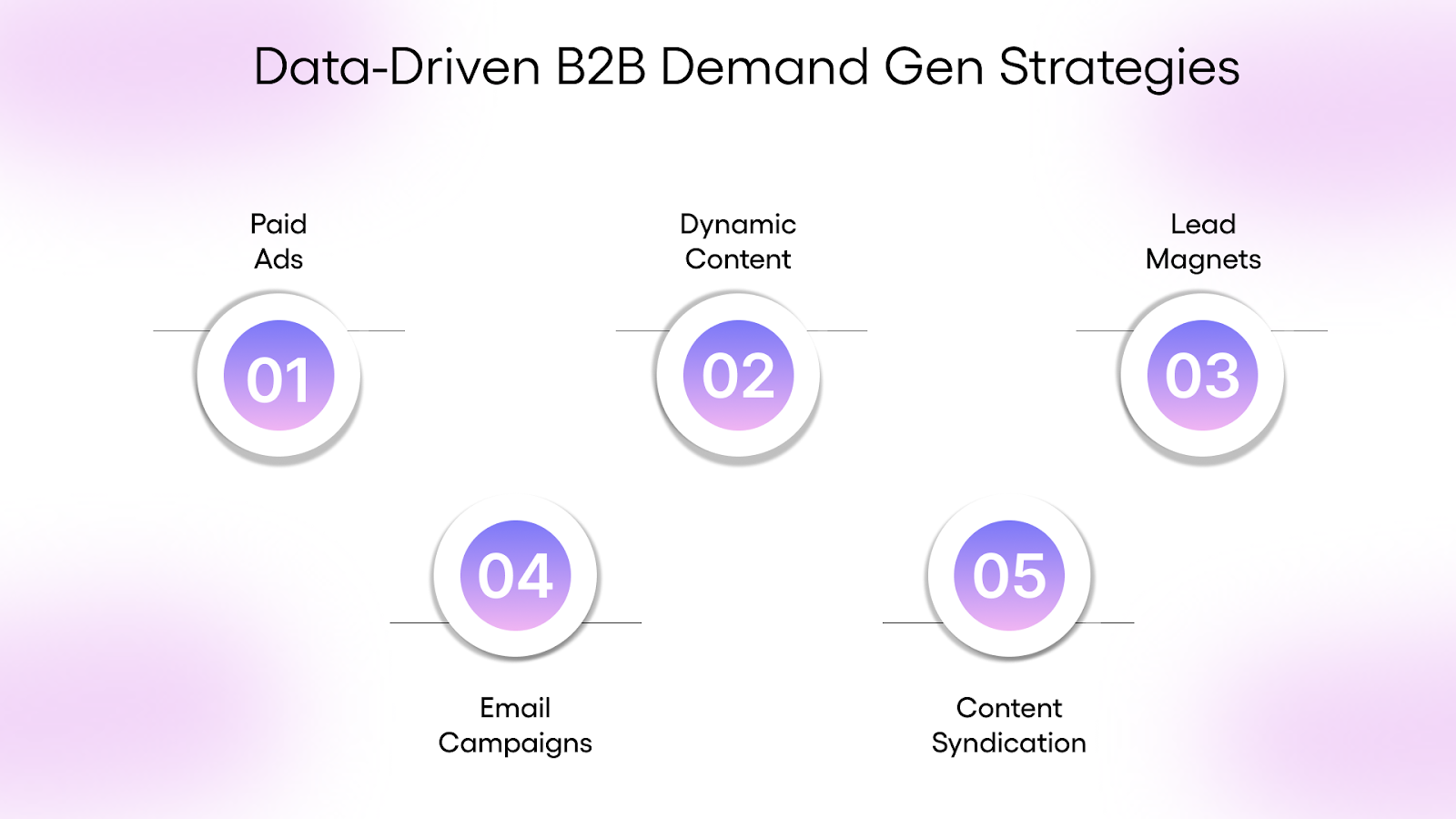
Reaching the right buyers takes more than sending bulk messages or waiting for leads to engage. A data-driven demand generation strategy helps you cut through noise, focus outreach, and move qualified prospects into sales conversations faster.
Here’s what to implement for predictable pipeline results and stronger MRR growth:
1. Paid Advertising & Remarketing
Paid ads help put your message in front of the right decision-makers at the right time. Remarketing reinforces your presence with those who showed interest but didn’t convert.
Key actions:
- Target based on roles, industry, and behavior, not just volume.
- Re-engage visitors who bounced before taking action.
- Keep your message focused on urgency or business value.
2. Dynamic Website Content
Static content doesn’t reflect where a visitor is in their buying journey. Dynamic content tailors messaging and CTAs to match buyer intent.
Best moves:
- Show different CTAs to returning or bottom-funnel visitors.
- Adjust messaging for SMBs versus enterprise-level prospects.
- Guide visitors to gated assets or conversion points.
3. Gated Resources and Lead Magnets
Offering high-value content in exchange for contact details helps you build a permission-based list of leads. These prospects are already warmed up and easier to qualify.
Formats that work:
- Industry-specific checklists, reports, or templates.
- Case studies showing real business results.
- Lead magnets that plug directly into your email campaigns.
4. Email Campaigns
Email is still the most direct and scalable way to drive demand when done right. Instead of blasting lists, high-performing campaigns use:
- Deep segmentation based on role, industry, and pain points
- Short, clear messaging that speaks to specific business goals
- Trigger-based follow-ups driven by real engagement (opens, clicks, replies)
- Low-friction CTAs that open conversations, not push demos
With the right data, timing, and copy, email becomes your fastest path to qualified leads and booked meetings—without the noise or guesswork.
5. Data-Driven Content Syndication
Getting your content in front of decision-makers, before they even land on your site, builds earlier brand familiarity and trust.
Where to focus:
- Syndicate top-performing assets to trusted industry platforms.
- Choose publishers with niche, role-based audiences.
- Track which content drives actual SQL conversions.
Each of these strategies works best when backed by clean data, defined goals, and continuous optimization.
Looking to turn these strategies into consistent MRR gains? Explore how Demand Generation helps businesses like yours run data-backed campaigns that convert intent into qualified sales conversations.
Also Read: How to Find Leads For Your Business Online
Common Data-Driven Demand Generation Mistakes to Avoid
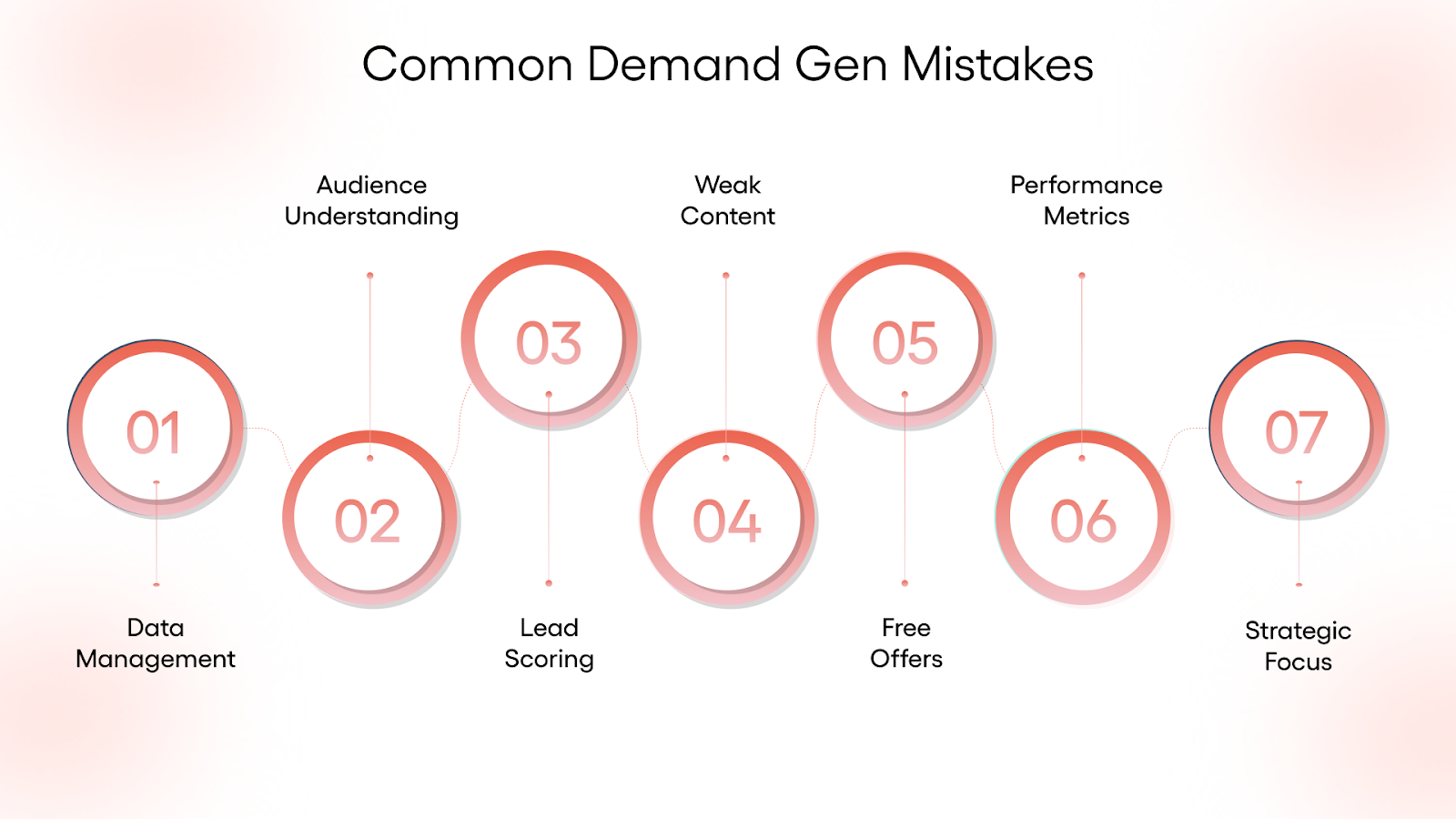
Even the best-planned campaigns can fall flat if the data behind them isn’t clean, relevant, or used correctly. And when you're aiming for consistent, high-quality leads and growing MRR, even small missteps can slow down your pipeline and frustrate your sales team. Here’s what to avoid, and how to stay on track.
1. Poor Marketing Data Management
If your contact data isn’t reliable, your outreach won’t be either. Old emails, wrong names, or sending messages to people who’ve never opted in, these all damage deliverability and brand reputation.
Here’s what to do instead:
- Clean up and validate your contact lists regularly
- Stick to CAN-SPAM rules for every email you send
- Avoid scraped lists or third-party data without opt-in
The Lead Market maintains verified contact sets based on firmographic and technographic filters, reducing bounces and improving inbox placement from day one.
2. Lack of Audience Understanding
You can write a great email, but if it’s not speaking to what your buyers care about, it won’t land. Many campaigns miss the mark because the message is too broad, too generic, or built on assumptions.
Here’s how to sharpen it:
- Let real buyer engagement guide your segments
- Talk about specific challenges, not vague benefits
- Adjust your tone by role, company size, or industry
At TLM, every outreach strategy draws from real buying signals, industry hiring spikes, pricing shifts, or expansion activity to make messaging feel timely and relevant, not random.
3. Ignoring Lead Scoring Models
Not every lead is worth passing to sales. Without a clear scoring system, your team ends up wasting time on people who aren’t ready or don’t fit.
Fix that by:
- Using scoring to prioritize high-intent leads
- Sending only SQLs to your sales team
- Tracking patterns that link to real MRR growth
4. Weak Content in Demand Generation
If your content doesn’t help the buyer, it’s just noise. Fluffy blogs, long-winded PDFs, or sales-heavy emails don’t build trust, and they won’t convert.
Make your content count by:
- Creating resources that reflect your buyer’s real challenges
- Leading with outcomes and insights, not product features
- Ending with clear CTAs like Book Meetings or Let’s Discuss How
5. No Value-Driven Free Offers
People don’t give out their email addresses just for anything. If your lead magnets don’t offer something useful, most won’t bother filling out the form.
Here’s what works better:
- Share checklists, calculators, or benchmarks that your audience actually wants
- Skip the fluff and vague promises
- Match the offer to where your buyer is in their decision process
6. Skipping Key Performance Metrics
You might see high open rates and think a campaign is working, but that’s not the full picture. If you’re not tracking what matters, you won’t know what to improve.
What to track instead:
- SQL conversion rates and cost per lead
- Campaign impact on actual pipeline, not vanity metrics
- Month-over-month changes tied to MRR growth
TLM’s reporting goes beyond opens and clicks, highlighting SQL conversion rates, MRR potential, and email sequences that truly drive pipeline lift.
7. Scattered Strategic Focus
Running too many disconnected campaigns across different platforms can create more chaos than results. Without a clear focus, efforts get diluted, and MRR stalls.
To stay aligned:
- Choose one core goal: SQLs, booked meetings, or retention
- Build all messaging around that outcome
- Centralized execution using one clean, consistent source of data
Rather than multi-channel confusion, TLM runs purpose-built campaigns, whether you're aiming for booked meetings, SQLs, or retargeting specific market segments.
Transform Demand Generation Into a Scalable Growth Channel with TLM
Most B2B teams put effort into demand generation, creating content, launching campaigns, and targeting outreach, but still don’t see steady pipeline growth. One common reason is a lack of structure. If your efforts aren't backed by clean data, buyer-specific messaging, and measurable actions, it's hard to see consistent results.
TLM helps solve that problem with a demand generation process shaped around buyer needs, not assumptions. The goal is simple: help you reach the right decision-makers, at the right time, with a message that fits their current priorities.
What TLM’s Demand Generation Strategy Covers
- Verified, permission-based contact lists through B2B Lead Generation
- Custom targeting using filters like industry, role, company size, and region
- CAN-SPAM compliant emails built around business value, not promotional claims
- Account-based campaigns aimed at high-value opportunities
- Sales Qualified Leads that are filtered based on fit, timing, and sales-readiness
Everything is built to reduce guesswork and support predictable MRR growth.
If you're looking to enter high-value verticals, land larger deals, or just clean up your sales funnel, Schedule a Meeting with TLM and see what a targeted demand strategy could do for your business.
FAQs
1. What is data-driven demand forecasting?
It’s the practice of using real-time data, past trends, and buyer behavior to predict future demand for your products or services. This helps you plan outreach, budget, and resources more accurately.
2. What is the demand generation process?
Demand generation is a long-term marketing strategy that focuses on building interest and trust with your ideal buyers. It starts with awareness and continues through engagement, nurturing, and conversion.
3. What are the six steps in the demand generation process?
The typical stages include identifying your audience, creating value-driven content, capturing interest, nurturing leads, handing off qualified prospects to sales, and tracking performance to improve results.
4. How to drive demand generation?
Start by understanding your audience's pain points, deliver content that solves their problems, and follow up with timely, relevant outreach. Companies like TLM (The Lead Market) do this through personalized, data-backed campaigns.


